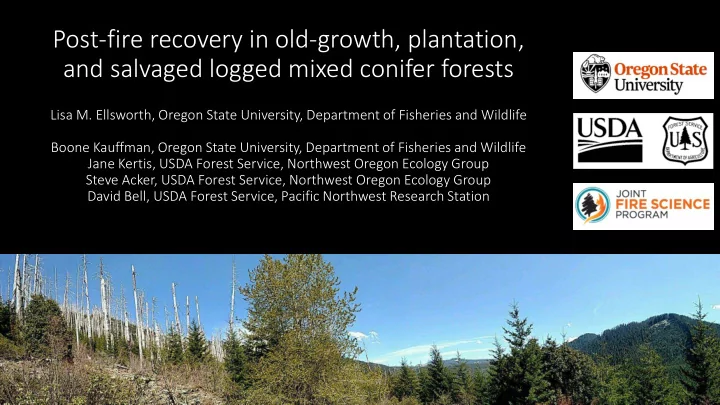

Post-fire recovery in old-growth, plantation, and salvaged logged mixed conifer forests Lisa M. Ellsworth, Oregon State University, Department of Fisheries and Wildlife Boone Kauffman, Oregon State University, Department of Fisheries and Wildlife Jane Kertis, USDA Forest Service, Northwest Oregon Ecology Group Steve Acker, USDA Forest Service, Northwest Oregon Ecology Group David Bell, USDA Forest Service, Pacific Northwest Research Station
Fire regimes characterized by variability - Time Mean Fire Return Intervals: 30-200 years (Tepley et al 2013) Western Hemlock and Douglas Fir Zones of Oregon and Washington Weisberg and Swanson 2003 Adapted from Jan Henderson, USDA Forest Service
Fire regimes characterized by variability – Type and Frequency Low Severity High Severity Mixed Severity Infrequent Frequent
Multiple Use Forests – Alter Successional Dynamics • Recreation • Environmental Services • Non-timber forest products • Timber products • Pre-fire Plantations • Post-fire Salvage Logging Management activities likely alter patterns of fuel succession
Current Research Objectives 1. Quantify the long-term trajectories of succession, fuels dynamics and potential future fire behavior as influenced by • prefire conditions (logged or old growth) • fire severity (low, moderate, high) • post-fire management (salvage, natural recovery)
Current Research Objectives 2. Determine how different fuel structures will impact reburn potential field fuel measurements • fire behavior modeling •
Mesic Mixed Conifer Forests Western Hemlock Zone Willamette National Forest • Warner Creek Fire 1991 – natural regeneration • Shady Beach 1988 – salvage and plantation Umpqua National Forest • Apple Fire 2002 – natural, plantation, and salvage • Spring 1996 or TBD
Methods 5 plots per forest type (Low, Moderate, High, Salvage, Plantation) 2 Fires/Fire Pairs (to date) Modified FIA plot design
Methods • Stand Structure • Species, dbh, live/dead • Large Trees (>10 cm dbh) • Small Trees/Understory (<10 cm dbh) • Allometric equations – Biomass • Fuel Structure • Depth and Cover • Canopy • Subcanopy • Understory • Shrub • Herbaceous • Litter/Duff • Fire Behavior Modeling (Fuel and Fire Tool) • Year 1 of 3 completed
Apple Fire – 15 years post-fire Canopy Trees (Douglas Fir and Western Hemlock) mean mean dbh dbh live/ha (cm) snags/ha (cm) low 1583 50 732 49 mod 2589 81 2038 62 high 2301 72 2166 73 salvage 0 2229 65 plant 973 31 1879 69
Apple Fire – 15 years post-fire Understory <10 cm dbh (Shrubs and Young Regeneration) live/ha dead/ha low 2643 0 mod 9904 158 high 10860 62 salvage 8726 30 plant 22611 53
Warner and Shady Beach – 26-29 years post-fire Canopy Trees (Douglas Fir and Western Hemlock) mean mean dbh dbh live/ha (cm) snags/ha (cm) low 1798 56 732 49 mod 1130 35 2038 62 high 1895 60 2166 73 salvage 995 31 2229 65 plant 873 27 1879 69
Warner and Shady Beach – 26-29 years post-fire Understory <10 cm dbh (Shrubs and Young Regeneration) live/ha dead/ha low 6752 446 mod 17803 1051 high 9904 1752 salvage 19268 1338 plant 5446 318
Reburn potential – Are the way we are managing our forests changing the next fire? • More in 2018-19 • Preliminary thoughts – 15 YPF (Apple Fire) • More large trees in natural forests – shading effect • Low severity plots very low understory – continued low severity patches? • Very dense understory in Plantations • Increased fuel moisture early • Extreme fire behavior late season
Reburn potential – Are the way we are managing our forests changing the next fire? • More in 2018-19 • Preliminary thoughts – 26-29 YPF • Larger, more trees regenerating in unmanaged high severity • Salvage plots very similar to moderate severity • Sparse canopy and very dense understory more severe fire? • Plantations – • Few, smaller trees AND sparser understory reduced fire potential? • Contrast to Apple – different management?
To be continued….. More fires sampled in 2018 • Comprehensive fuel profiles and fire • modeling Once vs Twice burned • Fires as barriers to future fire – • landscape modeling and management scenario development
Thanks • Willamette National Forest • Umpqua National Forest • Joint Fire Science Program • Field Crew: Trevor Bavarskas, Becca Crawford, Dani Jackson, Isabella Gabriel
Recommend
More recommend